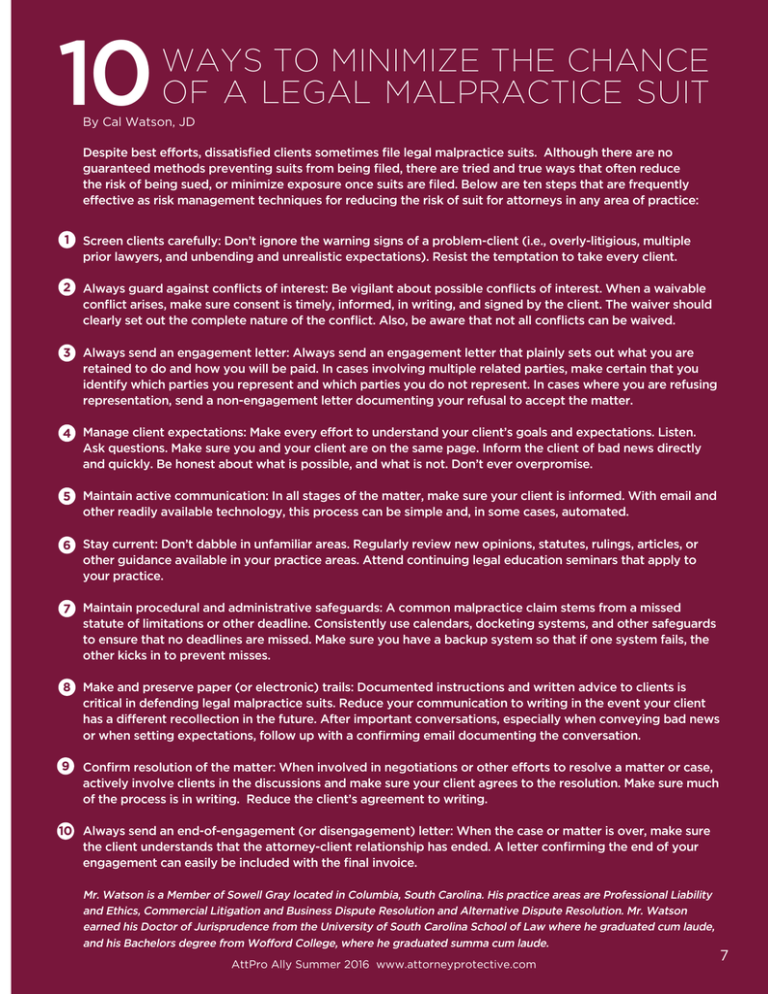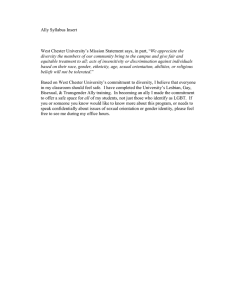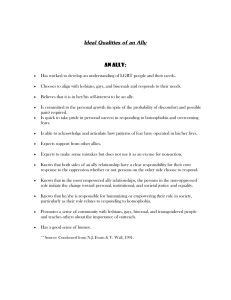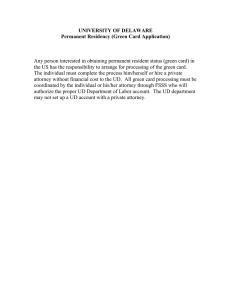
10
WAYS TO MINIMIZE THE CHANCE
OF A LEGAL MALPRACTICE SUIT
By Cal Watson, JD
Despite best efforts, dissatisfied clients sometimes file legal malpractice suits. Although there are no
guaranteed methods preventing suits from being filed, there are tried and true ways that often reduce
the risk of being sued, or minimize exposure once suits are filed. Below are ten steps that are frequently
effective as risk management techniques for reducing the risk of suit for attorneys in any area of practice:
1
Screen clients carefully: Don’t ignore the warning signs of a problem-client (i.e., overly-litigious, multiple
prior lawyers, and unbending and unrealistic expectations). Resist the temptation to take every client.
2 Always guard against conflicts of interest: Be vigilant about possible conflicts of interest. When a waivable
conflict arises, make sure consent is timely, informed, in writing, and signed by the client. The waiver should
clearly set out the complete nature of the conflict. Also, be aware that not all conflicts can be waived.
3 Always send an engagement letter: Always send an engagement letter that plainly sets out what you are
retained to do and how you will be paid. In cases involving multiple related parties, make certain that you
identify which parties you represent and which parties you do not represent. In cases where you are refusing
representation, send a non-engagement letter documenting your refusal to accept the matter.
4 Manage client expectations: Make every effort to understand your client’s goals and expectations. Listen.
Ask questions. Make sure you and your client are on the same page. Inform the client of bad news directly
and quickly. Be honest about what is possible, and what is not. Don’t ever overpromise.
5 Maintain active communication: In all stages of the matter, make sure your client is informed. With email and
other readily available technology, this process can be simple and, in some cases, automated.
6 Stay current: Don’t dabble in unfamiliar areas. Regularly review new opinions, statutes, rulings, articles, or
other guidance available in your practice areas. Attend continuing legal education seminars that apply to
your practice.
7 Maintain procedural and administrative safeguards: A common malpractice claim stems from a missed
statute of limitations or other deadline. Consistently use calendars, docketing systems, and other safeguards
to ensure that no deadlines are missed. Make sure you have a backup system so that if one system fails, the
other kicks in to prevent misses.
8 Make and preserve paper (or electronic) trails: Documented instructions and written advice to clients is
critical in defending legal malpractice suits. Reduce your communication to writing in the event your client
has a different recollection in the future. After important conversations, especially when conveying bad news
or when setting expectations, follow up with a confirming email documenting the conversation.
9
Confirm resolution of the matter: When involved in negotiations or other efforts to resolve a matter or case,
actively involve clients in the discussions and make sure your client agrees to the resolution. Make sure much
of the process is in writing. Reduce the client’s agreement to writing.
10 Always send an end-of-engagement (or disengagement) letter: When the case or matter is over, make sure
the client understands that the attorney-client relationship has ended. A letter confirming the end of your
engagement can easily be included with the final invoice.
Mr. Watson is a Member of Sowell Gray located in Columbia, South Carolina. His practice areas are Professional Liability
and Ethics, Commercial Litigation and Business Dispute Resolution and Alternative Dispute Resolution. Mr. Watson
earned his Doctor of Jurisprudence from the University of South Carolina School of Law where he graduated cum laude,
and his Bachelors degree from Wofford College, where he graduated summa cum laude.
AttPro Ally Summer 2016 www.attorneyprotective.com
7
This is AttPro Ally. A newsletter for today's modern law firm — AN ALLY IN A WORLD OF RISK.
5814 Reed Road
Fort Wayne, IN 46835-3568
Visit us at www.attorneyprotective.com or call (877) 728-8776.
LACY CRIPE, EDITOR
Policies are written by either National Liability & Fire Insurance Company or National Fire & Marine and administered by Attorney Protective. All
coverage is subject to specific policy terms and conditions. 2015 Attorney ProtectiveSM. ® All Rights Reserved. Information provided by AttPro
Ally is not intended as legal advice. This publication provides best practices for use in connection with general circumstances, and ordinarily does
not address specific situations. Specific situations should be discussed with legal counsel licensed in the appropriate jurisdiction. By publishing
practice and risk prevention tips, Attorney Protective neither implies nor provides any guarantee that claims can be prevented by use of the
suggested practices. Though the contents of AttPro Ally have been carefully researched, Attorney Protective makes no warranty as to its
accuracy, applicability or timeliness. Anyone wishing to reproduce any part of the AttPro Ally content must request permission from Attorney
Protective by calling 877-728-8776 or sending an email to lacy.cripe@attorneyprotective.com.
READ OUR ARTICLE ON DEALING WITH DIGITAL DETRACTORS ON PAGES 4-6.
8




